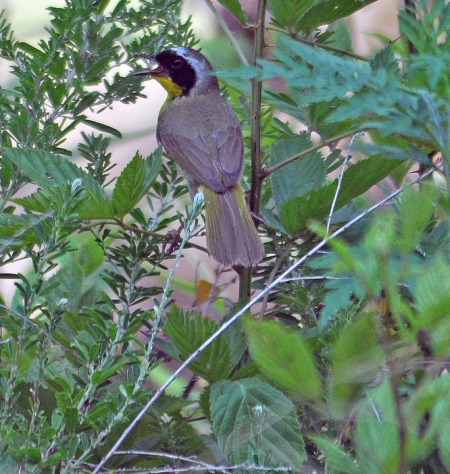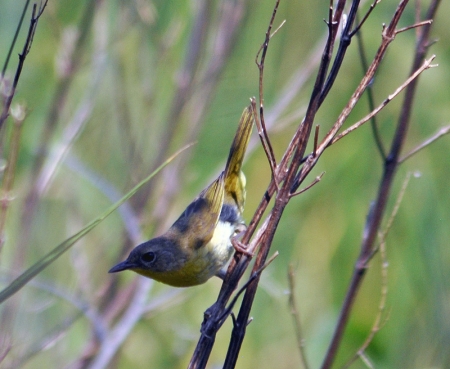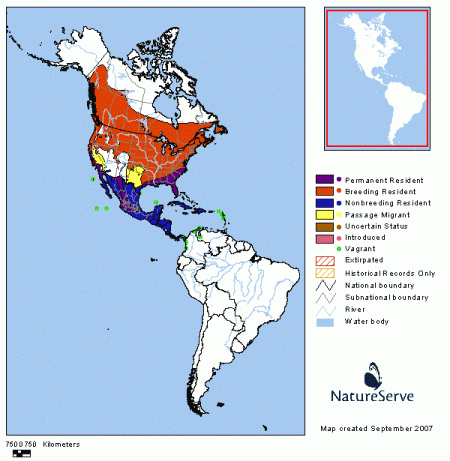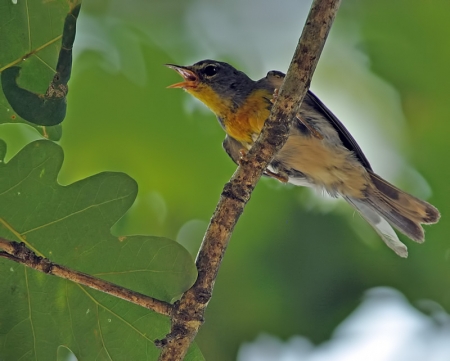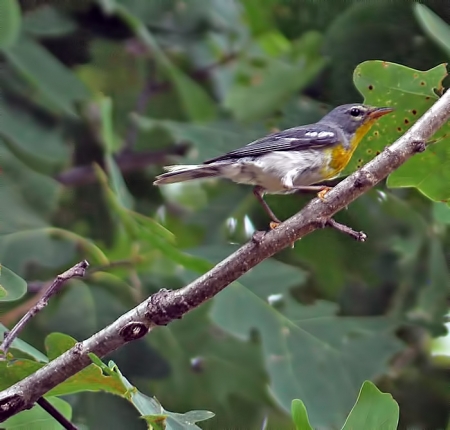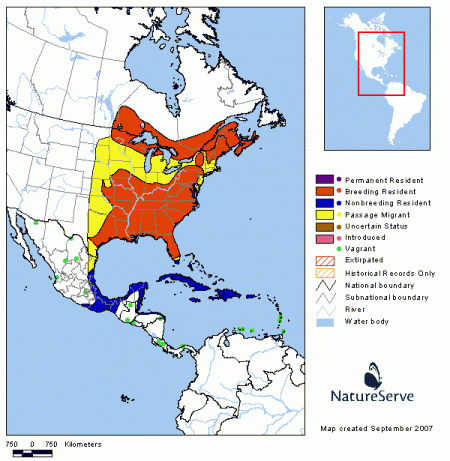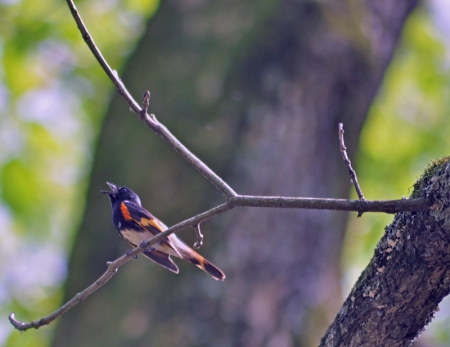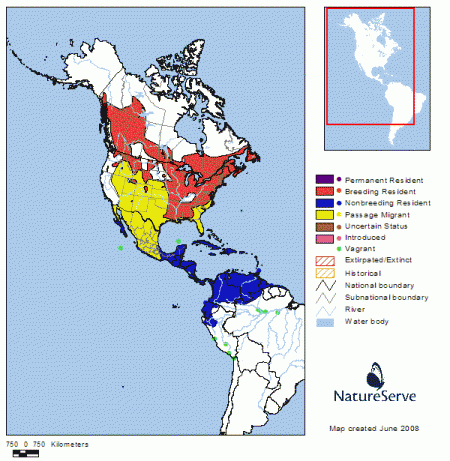I’ve been sitting on a group of warbler photos for a while now, planning to use them in a post but searching for a commonality between them (other than that they’re all, y’know, warblers) to keep the post from being basically a bunch of random photos. It finally dawned on me this morning that all three species prefer wet habitats and here in the Ozarks that means if you’re going to see on of these species, it’s most likely to be in the river bottoms, even though we do have other wetland habitats. So now that I have a theme, let’s get going.
Common Yellowthroat
As it’s name accurately indicates, the Common Yellowthroat is an extremely widespread species, occurring over most of the United States — it’s absent from only the desert southwest — and way north into Canada. It’s only a breeding resident over most of that range, but it’s a permanent resident over much of the southeastern states (and central Mexico as well.) In winter, the transient populations migrate to Central America and the Caribbean.
A small bird (11–14 cm,) the Yellowthroat is sexually dimorphic, as seen in the photos, with the male having a black mask with a bluish-white border that is lacking in the female. The mask is indistinct in immature males who also have a pale eye ring. It prefers marshes, especially those with cattails, but here in the Ozarks you’re going to find it in thickets, old field and canebrakes along streams. It’s also partial to fens and one of the highest densities of Yellowthroats I’ve seen in the Ozarks occurs in a large fen along Mill Creek in Carter County.
Yellowthroats nest just above the ground (or over water,) invariable in a densely vegetated area. Grass clumps, weeds, reeds, cattails and briar thickets are all likely locations. Three to six eggs (all the nests that I’ve seen have contained five) are incubated by the female for 11-13 days. Both parents care for the young who fledge in an additional 8-10 days. Like Mormons, polygamy has been known to occur in Yellowthroats.
Northern Parula
Northern Parulas aren’t as closely associated with wet situations as the other two species highlighted here, but the best locations to find them in the Ozarks usually involve cottonwoods and especially sycamores along a river or creek. The one shown here was photographed on my dry ridge, which is miles from any permanent stream. I’d like to note that the first photo was shot with the bird directly overhead while I was leaning back against the tree and trying to brace a Nikon D90, with a 200–500mm lens and an attached, dangling monopod. It’s only very lightly cropped for composition and I think it came out pretty nicely all things considered. The second photo was shot a few minutes later after the bird had flown to an adjacent tree, is much more heavily cropped and the quality shows.
Parulas usually build their nests in hanging clumps of moss (Spanish moss in the south, bearded moss in the north,) usually at the end of a branch, high in a tree. They nest in this area, but as far as I can tell we don’t have Spanish moss and not a heck of a lot of bearded moss, so they must fall back on more typical nesting materials in lieu of the mosses when necessary. I’ve never found a nest — I neither fly nor climb worth a hoot though I can fall spectacularly — so I can’t say for certain. Maybe there’s just more bearded moss present that I believe.
Clutch size is 3–5 eggs, incubated by the female for 12–14 days. The young are fed mainly by the female before leaving the nest after 10 days or so. Not yet able to fly, they remain dependent on their parents for a while. The female continues to do most of the feeding while the male sings. Mostly Hank Williams songs, but occasionally you’ll hear one break out his Johnny Cash.
American Redstart
American Redstarts are definitely associated with riparian habitats in Missouri, almost always found in a bottomland forest, mature or second-growth, along a creek or river. Creatures of the understory, not the canopy, males will sing from a prominent perch often only 10–20 feet above the forest floor. Their song is very loud and all out of proportion to their size.
The bird in the photo was singing at the downstream end of Big Tree Slough on the Current River in southern Carter County. The slough lies in the eastern edge of the floodplain in a mature hardwood forest that hasn’t been cut in over fifty years. I’ve also seen Hooded Warblers in the area, another species that likes the thickets and understory of riverine forests but is much less common than the Redstart.
With it’s bold black and orange coloring, the male Redstart is unlikely to be confused with any other species. In the female, the black is less bold and the orange replaced with yellow. A male doesn’t achieve full adult coloration until late in his second summer.
The female builds the nest in a fork of the lower branches of a tree or shrub. They must do a very good job of hiding them because we have many Redstarts and I’ve spent a good amount of time looking for their nests without success. Typically there is only one brood with a clutch size of 2–5 with the smaller clutches occurring in later nestings. The female incubates the eggs for 8–10 days and the young leave the nest after 8–9 days of tending by both parents. If a nest is lost or destroyed, the female may retry up to three times.
Ok, I’ve now used all the photos I had uploaded previously, so my OCD should finally allow me to move on to other topics. Next up, Tiger Beetles and then back to crayfish, I think. I have a crap load (to use the technical term) of crayfish stuff and that OCD is screaming at me to use it.
Range Maps: Ridgely, R.S., T.F. Allnutt, T. Brooks, D.K. McNicol, D.W. Mehlman, B.E. Young, and J.R. Zook. 2003. Digital Distribution Maps of the Birds of the Western Hemisphere, version 1.0. NatureServe, Arlington, Virginia, USA.
